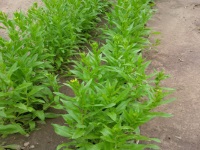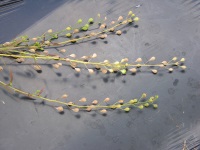Guelph ON - There’s an oilseed that represents a new crop opportunity for Ontario farmers: camelina.
Although grown in Western Canada, it has not yet gained a foothold in Ontario, but researchers from the Ontario Ministry of Agriculture, Food and Rural Affairs (OMAFRA) and the University of Guelph are looking to change that.

They’re currently conducting plot trials to see how this cool climate crop performs here and how it might best fit into a typical Ontario cash crop rotation.
According to OMAFRA industrial crops specialist Jim Todd, camelina, like canola, is a brassica, but has agronomic characteristics that make it a more appealing crop than its popular relative.
“Camelina has a shorter growing season, and more frost and drought tolerance. It also has some shatter resistance not seen in canola, it’s cheaper to grow, and some of the common canola pests, like swede midge, are not a problem for camelina,” Todd explains.
The challenge in the past has been finding a market, but that is changing with new oilseed uses emerging.
“There are new uses for camelina in food and feed that could make this an attractive crop for farmers to add to their rotation,” believes Jeff Schmalz, CEO of Oilseed Innovation Partners, whose mandate is to create and encourage new opportunities for Canadian oilseeds.

Camelina seed is high in omega-3 fatty acids and protein and the oil is shelf stable, making it ideally suited for both human and animal nutrition uses. It has been registered for use, for example, as a fish oil replacement in Atlantic salmon production. Camelina meal has been approved as a feed ingredient for poultry, replacing up to 12 per cent of meal in broiler and 10 per cent in laying hen diets, and can also be used in swine and beef cattle rations.
Camelina lends itself well to inter- and relay-cropping as it can be planted in late September, early October or in late March to early April, depending on the variety selected.
The Ontario plot trials are currently testing winter camelina varieties with both full and short season soybeans: relay-cropping soybeans after the camelina comes off in the spring or inter-cropping soybeans into the winter camelina in late spring. They’re also investigating inter-cropping spring camelina varieties into winter wheat.
“We are curious know how it will perform here and once we have yield data, we can get a better picture of the economics,” Todd says.
The project started in fall 2016, with plots at Ridgetown, Simcoe and Winchester. Germination was poor that first year in both Ridgetown and Simcoe, but all three sites had well-established stands by fall 2017 and good yield results are anticipated for harvest in 2018.
Camelina seed can be drilled in or broadcast and can be harvested with standard combine equipment. Pest management is an issue, though, with few product registrations, as is lack of local oil extraction capacity – camelina grown in western Canada is currently shipped to the U.S. for crushing.
Source : Ontario Ministry of Agriculture, Food and Rural Affairs